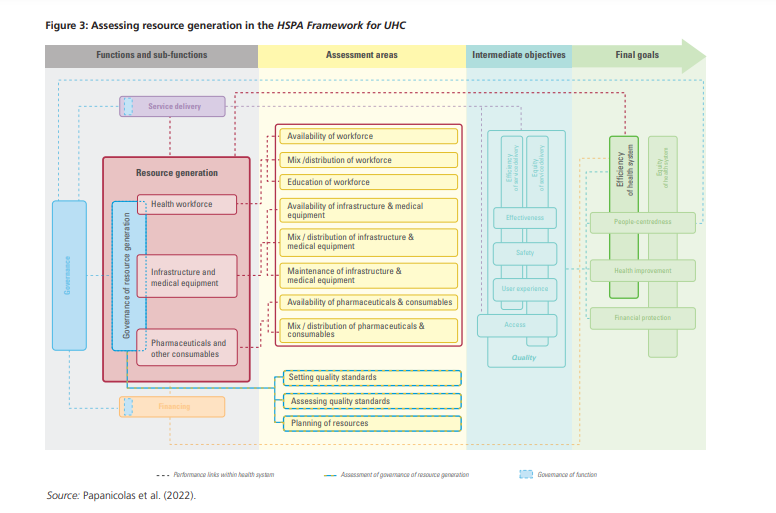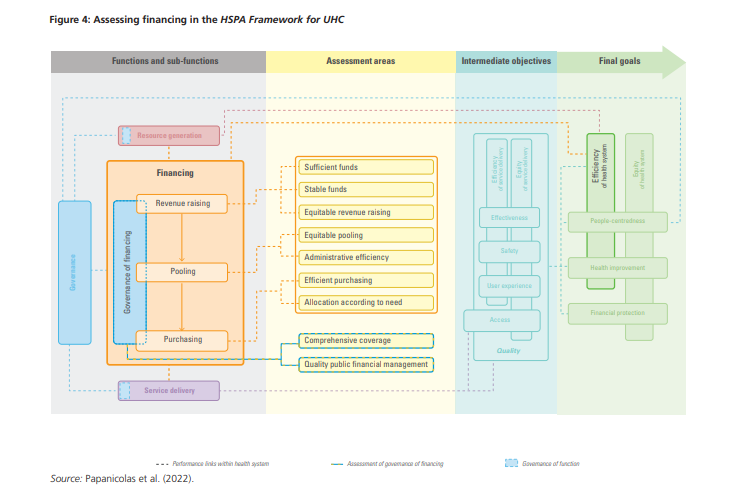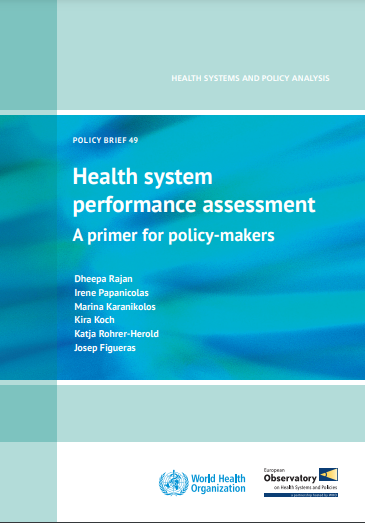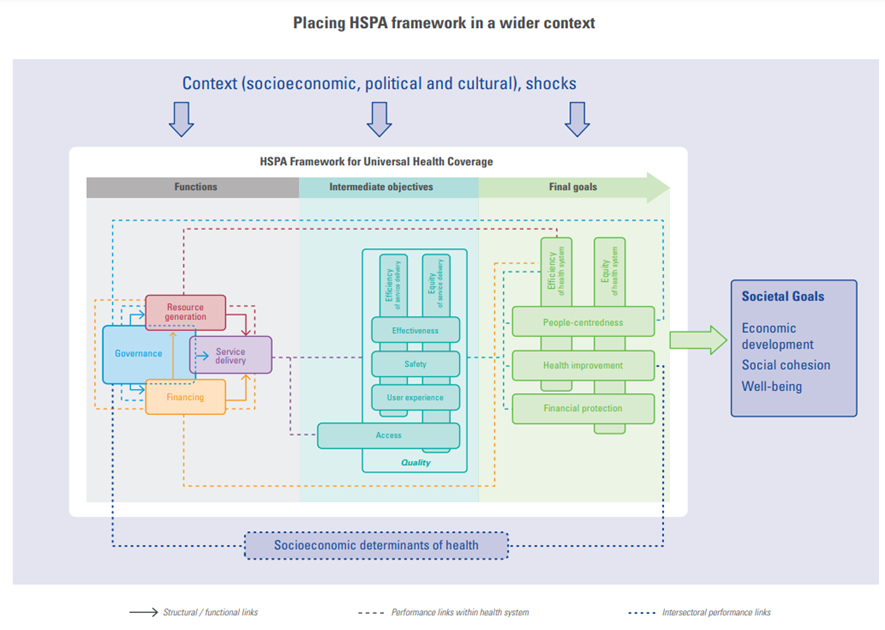Health & Care Transformation (HCT)
Management Institute
Joaquim Cardoso MSc*
Chief Strategy Officer, Researcher and Editor
November 9, 2022
*MSc from London Business School — MIT Sloan Masters Program
Source: The European Observatory / WHO
ORIGINAL PUBLICATION (excerpt)

Health system performance assessment — A primer for policy-makers
The European Observatory
Dheepa Rajan, Irene Papanicolas, Marina Karanikolos, Kira Koch, Katja Rohrer-Herold, Josep Figueras
November 2022
Key messages
Increasing health system performance is critical in creating resilient health systems.
If health policies are to foster the ability to withstand shocks like the COVID-19 pandemic, they need to focus on the right interventions that strengthen health systems — those that improve performance.
1.Assessing the performance of a health system effectively is the first step to improving it.
- This requires a conceptual lens through which to view the health system structures, its inputs and the outputs and outcomes that they feed into.
2.The Health System Performance Assessment (HSPA) Framework for Universal Health Coverage (UHC) offers policy-makers a conceptual tool to assess performance effectively.
- It provides a rigorous description of the four health system functions — governance, resource generation, financing and service delivery — and their sub-functions that matter most for the function-level and overall system performance.
- It builds on existing tools and frameworks but orients the analysis of health system assessment exercises towards system performance.
- It identifies impacts on health system performance and encourages operational focus.
3. The HSPA Framework for UHC has real-world applications and helps direct policy action.
- It allows policy-makers to understand how the health system works and how its functions and sub-functions are linked to the “assessment areas” that explain performance.
- It provides an explanation of the health system bottlenecks that contribute to specific policy challenges.
- This will support efforts to pinpoint the person, group or institution that can and should take responsibility for remedial action and promote accountability.
- Its insights into the governance function will help policymakers to use governance as a lever to achieve health system goals.

Executive summary
The post-pandemic focus on resilient health systems will require robust health system assessments and performance analysis.
The Health System Performance Assessment Framework for Universal Health Coverage offers a conceptual lens for a comprehensive assessment of health system performance
The post-pandemic focus on resilient health systems will require robust health system assessments and performance analysis.
The global COVID-19 pandemic serves as a stark reminder that a robust and resilient health system is one of the best defences against health threats.
Yet ensuring a strong system involves a number of policy actions.
These need to be prioritized and resourced based on the best available evidence, which in turn requires a health system to be monitored, and regularly assessed, in order to build on its strengths and overcome its shortcomings.
The global COVID-19 pandemic serves as a stark reminder that a robust and resilient health system is one of the best defences against health threats.
Yet ensuring a strong system involves a number of policy actions.
These need to be prioritized and resourced based on the best available evidence, which in turn requires a health system to be monitored, and regularly assessed, in order to build on its strengths and overcome its shortcomings.
Assessing health systems means delving into fundamental questions on the system’s boundaries, component elements and goals, …
… and the new Health System Performance Assessment (HSPA) Framework for Universal Health Coverage (UHC) is a tool that will help policy-makers to address those questions.
The framework stems from the volume Health System Performance Assessment: A Framework for Policy Analysis, which seeks to find an optimal, harmonized solution to assessment, given the various perspectives including expert appraisal and the evidence available.
Both the study and this brief are informed by the underlying understanding that, in many cases, there is no right or wrong answer.
The study and brief draw on a range of tools and frameworks for health system-wide assessment exercises and the efforts of a dedicated technical working group.
Tools focused on evaluating the current structure of the health system, often through the conceptual framework of health system functions or building blocks tended to be preoccupied with in-depth descriptions of system structures and features as a route to identify system strengths and failures.
Tools that placed an emphasis on evaluating how well the system is performing overall, by examining the extent to which health systems are meeting health system goals, by contrast tended to draw more on quantitative measures and analytical methods, often referred to as HSPA.
Ultimately, however, the business of strengthening health systems relies on a comprehensive understanding of what systems look like, how they perform and what structures work (or do not) in attaining optimal performance.
A crosscutting approach is needed to clarify the relationship between what health system actors do and the goals those actors wish to achieve, and to identify the connection between health system inputs, outputs and outcomes.
This is critical in understanding the link between the performance of individual health system functions and the performance of the health system overall.
Ultimately, however, the business of strengthening health systems relies on a comprehensive understanding of what systems look like, how they perform and what structures work (or do not) in attaining optimal performance.
This is precisely the intent of the HSPA Framework for UHC, which mobilizes a long tradition of work on performance to help policy-makers assess how health system structures (inputs, outputs and outcomes) can be strengthened to serve people better.
The HSPA Framework for UHC (Figure 1) elaborates on the four health system functions, taken from the World Health Report 2000 — governance, resource generation, financing and service delivery
Figure 1: HSPA Framework for UHC — an overview

Note: HSPA, Health System Performance Assessment.
Source: Papanicolas et al. (2022).
The HSPA Framework for UHC focuses on health actions within the traditional health care remit but also includes public health and health promotion activities that contribute to health improvement.
While it is beyond the scope of the framework, the influence of the socioeconomic, political and cultural factors on health is explicitly acknowledged by placing the health system within this broader context and by recognizing that the health system is meant to contribute to the wider societal goals.
The framework, therefore, acts as a guide to assessing those actions that health system actors can feasibly undertake, while explicitly acknowledging the substantial impact on health of a range of socioeconomic determinants outside the boundaries of the health system.
The framework builds on the four core health system functions, taken from the World Health Report 2000 — governance, resource generation, financing and service delivery — and lays out a set of sub-functions for each of them.
Sub-functions represent the key topical areas that matter most for function-level performance and for the function’s contribution to overall system performance.

- 1.Governance
- 2.Resource Generation
- 3.Financing
- 4.Service Delivery
1.Governance
The four governance sub-functions are: policy and vision, stakeholder voice, information and intelligence, and regulation and legislation.
Figure 2: Assessing governance in the HSPA Framework for UHC

Source: Papanicolas et al. (2022).
They encompass the core actions of steering the sector with …
… a clear policy direction (policy and vision); ensuring that all stakeholders, including the public, communities and civil society, are meaningfully included in policy decisions (stakeholder voice); fostering a culture of data-driven, evidence-based decision-making (information and intelligence); and leveraging legal frameworks to protect the population’s health and ensure progress on health system goals (legislation and regulation).
Each of these sub-functions is further associated with clearly defined assessment areas, which are areas whose appraisal is needed to grasp function-level performance.
The framework differentiates overall health system governance from governance actions that are specifically linked to the governance of the other three functions.
For example, the “governance of financing” includes specific governance actions relating to financing activities, such as public financial management and decisions linked to benefit package coverage.
The “governance of resource generation” includes activities such as health workforce planning and management of procurement systems.
The “governance of service delivery” relates to management and decision-making within units of service delivery (including health centre, district, primary health care service network), service integration and quality assurance mechanisms.
The salient point here is that when assessing the governance function, both overall system-wide governance, as well as the governance issues relating to the other three functions (financing, resource generation and service delivery), need to be examined to understand whether the governance function is performing well and is also enabling the system to perform well.
2.Resource generation
The resource generation function is purposefully placed in the HSPA Framework for UHC between governance and service delivery, …
… indicating that the governance function enables the resource generation function, and resource generation feeds into, and enables, the service delivery function.
Resource generation sub-functions are health workforce; infrastructure and medical equipment; and pharmaceuticals and other consumables, representing the principal inputs that need to come together in the right mix at the right place at the right time within the service delivery function, underpinned by governance and financing.

3.Financing
The financing function includes the sub-functions of revenue raising, pooling, and purchasing.

Revenue raising refers to the ways in which money is brought into the health system.
Pooling refers to the accumulation of prepaid funds that can be used to purchase goods and services on behalf of a population.
The pooling function is largely intended to ensure that resources are distributed in an equitable way and also to enable efficiency through economies of scale.
Purchasing refers to payers using funds to pay for health care on behalf of a population.
It is mainly concerned with getting resources to those who need them most and doing this efficiently by minimizing costs.
As a result, purchasing can have a major impact on intermediate objectives such as quality and, ultimately, health outcomes.
4.Service delivery
Service delivery is a broad concept and difficult to separate into discrete sub-functions that match organizational structures (for example, levels — primary, secondary, tertiary; purpose — preventive, curative, rehabilitative, long-term care; platforms — primary care centre, hospital; modes — outpatient, inpatient, day care, home care) of health systems globally.

Instead, the framework broadly distinguishes the sub-functions of public health, primary care and specialist care, allowing specific services to be attributed to those sub-functions according to a specific country context.
Assessment areas of all service delivery sub-functions coincide with intermediate health system objectives and include aspects of quality (effectiveness, safety, user experience, as well as efficiency and equity of service delivery) and access to services.
The HSPA Framework for UHC brings together these four functions, intermediate objectives and the final goals, and places the health system within a wider socioeconomic context
The HSPA Framework for UHC is grounded in the premise that any whole-of-sector exercise should collect information on, and examine the performance of, both the functions and the extent to which system goals are achieved. Linking the two in practice rests on a solid understanding that high-performing functions are the basis for high-performing health systems.
The links depicted in the framework by dotted lines (see Figure 6) show how each of the functions is connected to the others, and to the intermediate objectives and final health system goals. The functions may affect any one or several of the final goals directly or indirectly. For the most part, the way health system functions impact on goals is through the service delivery function with its assessment areas being captured in the intermediate objectives of the system. In addition, the interaction between the functions, notably governance’s interplay with all other functions, represents a far-reaching lever to impact on system objectives.
The framework is principally a conceptual aid to orient the analysis of information collected through health system assessment exercises towards system performance
The framework is a conceptual aid that policy-makers can use to identify areas for health system improvement. It is designed so that the starting point can be any health system function, sub-function, assessment area, indicative measure, etc.
A health system bottleneck can then be traced backwards to explore possible origins (areas to be targeted for improvement), or traced forwards to understand potential influences on health system performance. Doing so may not provide all the answers sought; however, it can serve as a solid basis for in-depth analysis. Importantly, the framework has been designed with existing assessment tools in mind, so that performance indicators from other sources that are already collected can be easily mapped onto it.
The framework’s conceptual lens can therefore help to analyse information and data collected within the context of a system-wide assessment, facilitating a more nuanced understanding of how inputs and structures contribute to system performance, or vice versa, that is, how system performance has been influenced by inputs and structures. Making such links while analysing health system assessment information not only helps to identify challenges that require remedial action but also assists in pinpointing which person, group, or institution should and can take responsibility for that action — thereby promoting accountability and providing a basis to address the health system challenge.
About the authors & affiliations:
Dheepa Rajan, European Observatory for Health Systems and Polices, Brussels
Irene Papanicolas, Brown University, Providence
Marina Karanikolos, European Observatory for Health Systems and Policies, London
Kira Koch, Health Systems Governance and Financing Department, WHO, Geneva
Katja Rohrer-Herold, Health Systems Governance and Financing Department, WHO, Geneva
Josep Figueras, European Observatory for Health Systems and Policies, Brussels
Editors
Matthias Wismar
Ewout van Ginneken
Series Editor
Anna Sagan
Managing Editors
Jonathan North
Lucie Jackson
Originally published at: https://eurohealthobservatory.who.int/
ORIGINAL PUBLICATION













